Rasmussen University: Early Childhood Education Assessment Report
VerifiedAdded on 2023/04/21
|9
|1257
|300
Report
AI Summary
This report examines various early childhood assessment methods, focusing on checklists, anecdotal reports, and rating scales. It provides an overview of each method, including the type of assessment, the domains they focus on (social-emotional, linguistic, environmental, etc.), and their purposes (curriculum evaluation, child behavior, language acquisition, developmental screening). The report is supported by credible references and includes a reflection on the chosen tools, considering personal style preferences, information focus, and how these tools support child development. Visual samples of the tools are also included. The report emphasizes the importance of these tools in monitoring student behavior, progress, and supporting partnerships between educators and families to enhance child development and learning outcomes. The student has provided examples of the tools and how they are used in practice, making it a valuable resource for educators and those studying early childhood education.
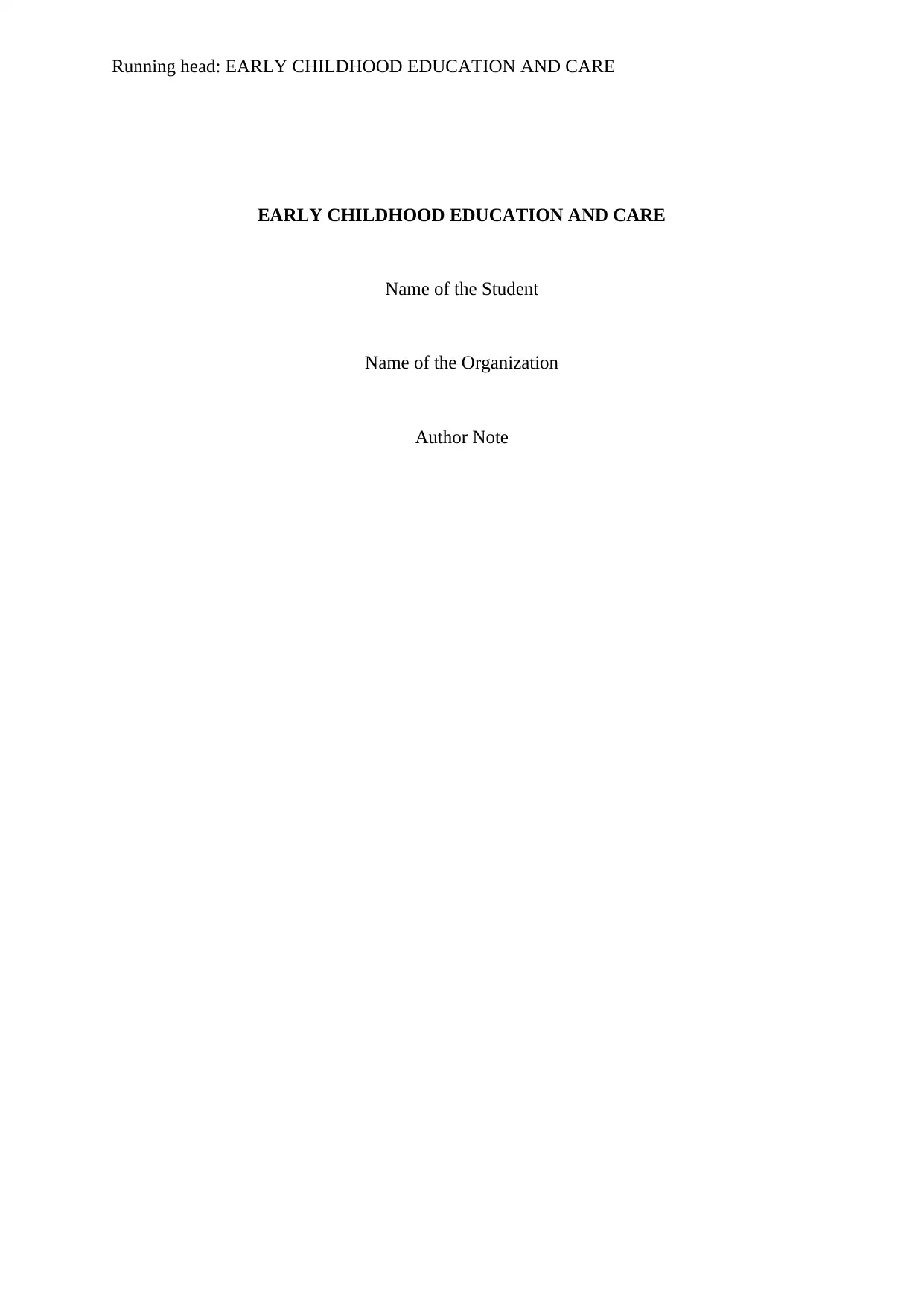
Running head: EARLY CHILDHOOD EDUCATION AND CARE
EARLY CHILDHOOD EDUCATION AND CARE
Name of the Student
Name of the Organization
Author Note
EARLY CHILDHOOD EDUCATION AND CARE
Name of the Student
Name of the Organization
Author Note
Paraphrase This Document
Need a fresh take? Get an instant paraphrase of this document with our AI Paraphraser
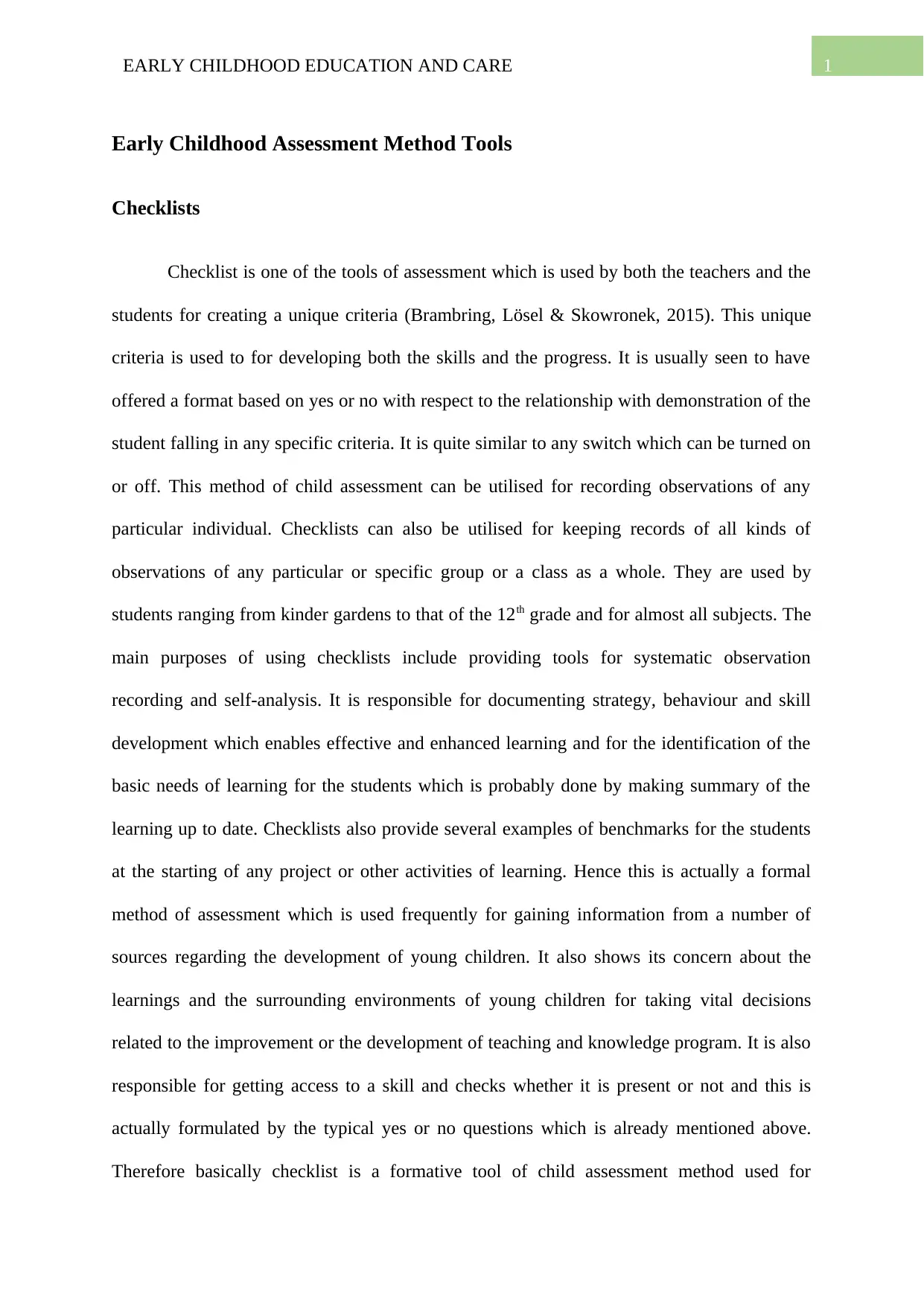
1EARLY CHILDHOOD EDUCATION AND CARE
Early Childhood Assessment Method Tools
Checklists
Checklist is one of the tools of assessment which is used by both the teachers and the
students for creating a unique criteria (Brambring, Lösel & Skowronek, 2015). This unique
criteria is used to for developing both the skills and the progress. It is usually seen to have
offered a format based on yes or no with respect to the relationship with demonstration of the
student falling in any specific criteria. It is quite similar to any switch which can be turned on
or off. This method of child assessment can be utilised for recording observations of any
particular individual. Checklists can also be utilised for keeping records of all kinds of
observations of any particular or specific group or a class as a whole. They are used by
students ranging from kinder gardens to that of the 12th grade and for almost all subjects. The
main purposes of using checklists include providing tools for systematic observation
recording and self-analysis. It is responsible for documenting strategy, behaviour and skill
development which enables effective and enhanced learning and for the identification of the
basic needs of learning for the students which is probably done by making summary of the
learning up to date. Checklists also provide several examples of benchmarks for the students
at the starting of any project or other activities of learning. Hence this is actually a formal
method of assessment which is used frequently for gaining information from a number of
sources regarding the development of young children. It also shows its concern about the
learnings and the surrounding environments of young children for taking vital decisions
related to the improvement or the development of teaching and knowledge program. It is also
responsible for getting access to a skill and checks whether it is present or not and this is
actually formulated by the typical yes or no questions which is already mentioned above.
Therefore basically checklist is a formative tool of child assessment method used for
Early Childhood Assessment Method Tools
Checklists
Checklist is one of the tools of assessment which is used by both the teachers and the
students for creating a unique criteria (Brambring, Lösel & Skowronek, 2015). This unique
criteria is used to for developing both the skills and the progress. It is usually seen to have
offered a format based on yes or no with respect to the relationship with demonstration of the
student falling in any specific criteria. It is quite similar to any switch which can be turned on
or off. This method of child assessment can be utilised for recording observations of any
particular individual. Checklists can also be utilised for keeping records of all kinds of
observations of any particular or specific group or a class as a whole. They are used by
students ranging from kinder gardens to that of the 12th grade and for almost all subjects. The
main purposes of using checklists include providing tools for systematic observation
recording and self-analysis. It is responsible for documenting strategy, behaviour and skill
development which enables effective and enhanced learning and for the identification of the
basic needs of learning for the students which is probably done by making summary of the
learning up to date. Checklists also provide several examples of benchmarks for the students
at the starting of any project or other activities of learning. Hence this is actually a formal
method of assessment which is used frequently for gaining information from a number of
sources regarding the development of young children. It also shows its concern about the
learnings and the surrounding environments of young children for taking vital decisions
related to the improvement or the development of teaching and knowledge program. It is also
responsible for getting access to a skill and checks whether it is present or not and this is
actually formulated by the typical yes or no questions which is already mentioned above.
Therefore basically checklist is a formative tool of child assessment method used for
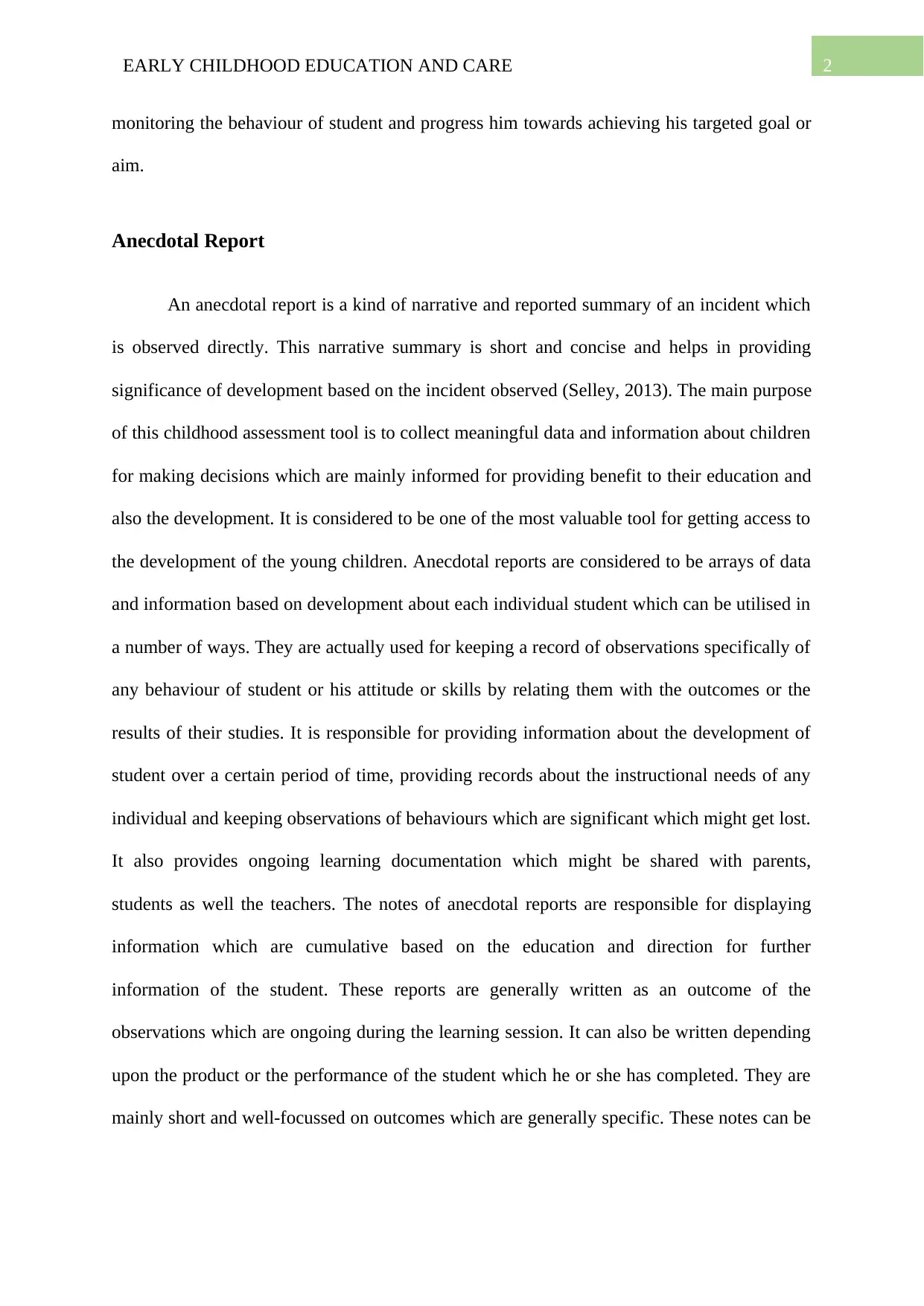
2EARLY CHILDHOOD EDUCATION AND CARE
monitoring the behaviour of student and progress him towards achieving his targeted goal or
aim.
Anecdotal Report
An anecdotal report is a kind of narrative and reported summary of an incident which
is observed directly. This narrative summary is short and concise and helps in providing
significance of development based on the incident observed (Selley, 2013). The main purpose
of this childhood assessment tool is to collect meaningful data and information about children
for making decisions which are mainly informed for providing benefit to their education and
also the development. It is considered to be one of the most valuable tool for getting access to
the development of the young children. Anecdotal reports are considered to be arrays of data
and information based on development about each individual student which can be utilised in
a number of ways. They are actually used for keeping a record of observations specifically of
any behaviour of student or his attitude or skills by relating them with the outcomes or the
results of their studies. It is responsible for providing information about the development of
student over a certain period of time, providing records about the instructional needs of any
individual and keeping observations of behaviours which are significant which might get lost.
It also provides ongoing learning documentation which might be shared with parents,
students as well the teachers. The notes of anecdotal reports are responsible for displaying
information which are cumulative based on the education and direction for further
information of the student. These reports are generally written as an outcome of the
observations which are ongoing during the learning session. It can also be written depending
upon the product or the performance of the student which he or she has completed. They are
mainly short and well-focussed on outcomes which are generally specific. These notes can be
monitoring the behaviour of student and progress him towards achieving his targeted goal or
aim.
Anecdotal Report
An anecdotal report is a kind of narrative and reported summary of an incident which
is observed directly. This narrative summary is short and concise and helps in providing
significance of development based on the incident observed (Selley, 2013). The main purpose
of this childhood assessment tool is to collect meaningful data and information about children
for making decisions which are mainly informed for providing benefit to their education and
also the development. It is considered to be one of the most valuable tool for getting access to
the development of the young children. Anecdotal reports are considered to be arrays of data
and information based on development about each individual student which can be utilised in
a number of ways. They are actually used for keeping a record of observations specifically of
any behaviour of student or his attitude or skills by relating them with the outcomes or the
results of their studies. It is responsible for providing information about the development of
student over a certain period of time, providing records about the instructional needs of any
individual and keeping observations of behaviours which are significant which might get lost.
It also provides ongoing learning documentation which might be shared with parents,
students as well the teachers. The notes of anecdotal reports are responsible for displaying
information which are cumulative based on the education and direction for further
information of the student. These reports are generally written as an outcome of the
observations which are ongoing during the learning session. It can also be written depending
upon the product or the performance of the student which he or she has completed. They are
mainly short and well-focussed on outcomes which are generally specific. These notes can be
⊘ This is a preview!⊘
Do you want full access?
Subscribe today to unlock all pages.

Trusted by 1+ million students worldwide
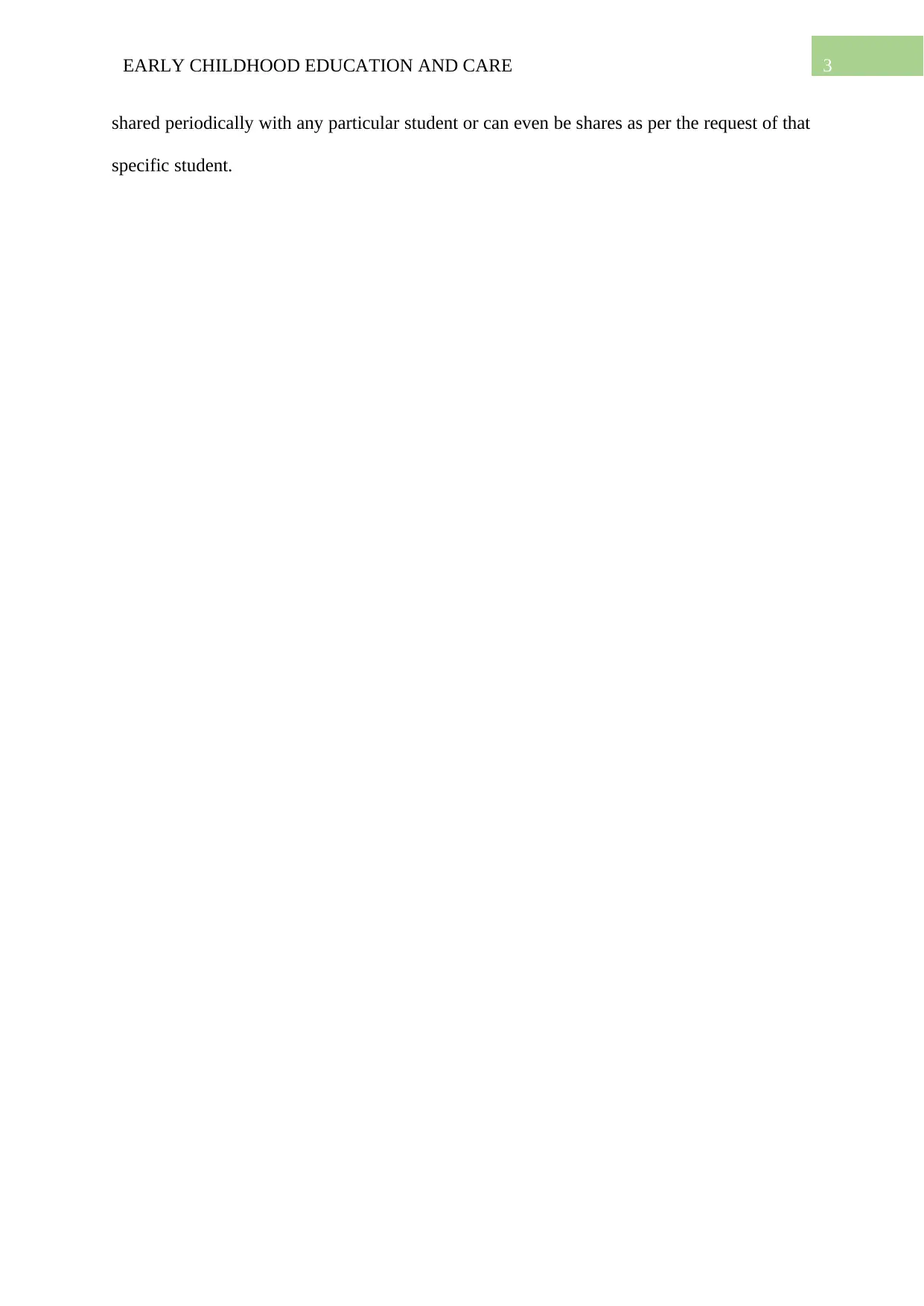
3EARLY CHILDHOOD EDUCATION AND CARE
shared periodically with any particular student or can even be shares as per the request of that
specific student.
shared periodically with any particular student or can even be shares as per the request of that
specific student.
Paraphrase This Document
Need a fresh take? Get an instant paraphrase of this document with our AI Paraphraser
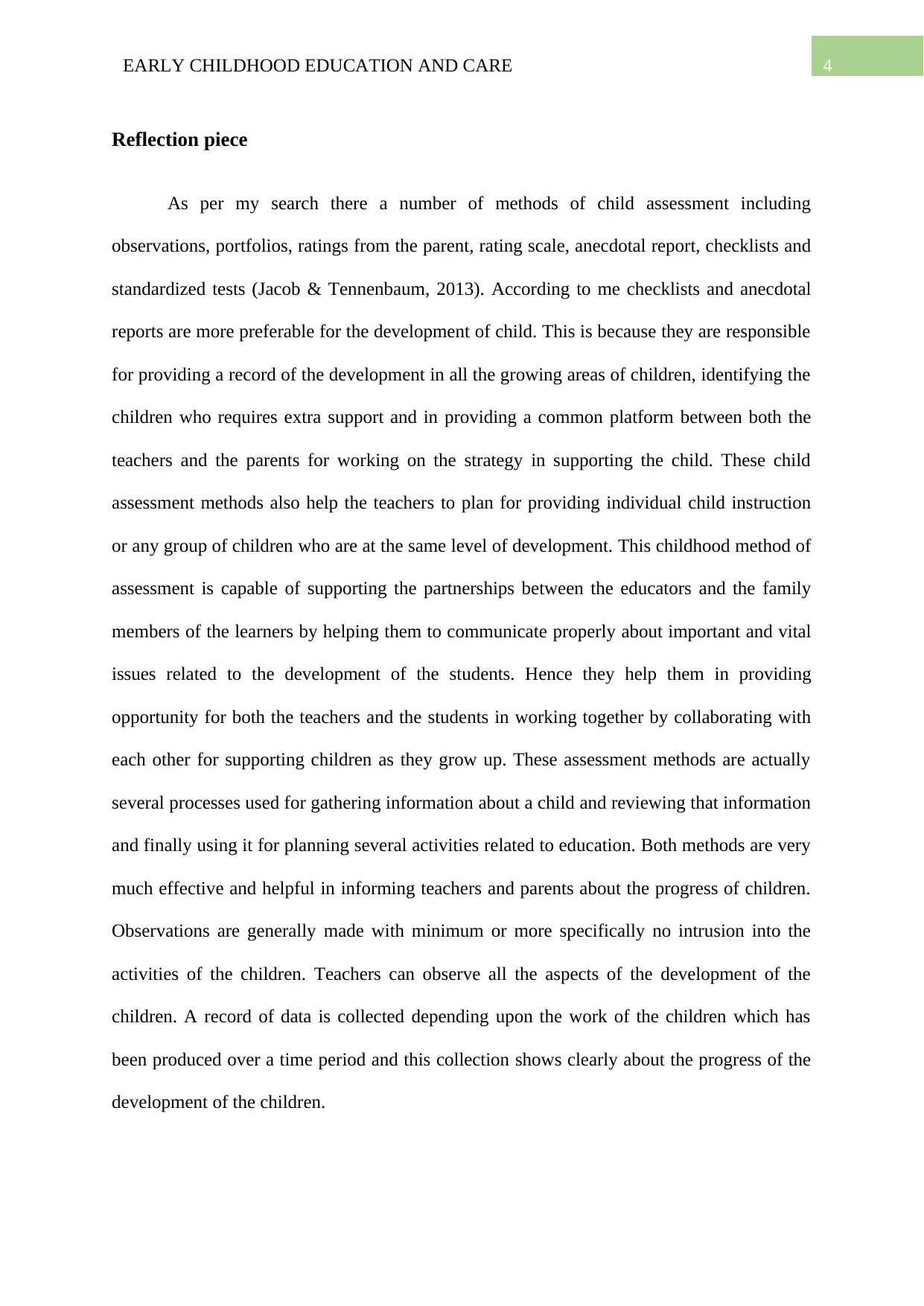
4EARLY CHILDHOOD EDUCATION AND CARE
Reflection piece
As per my search there a number of methods of child assessment including
observations, portfolios, ratings from the parent, rating scale, anecdotal report, checklists and
standardized tests (Jacob & Tennenbaum, 2013). According to me checklists and anecdotal
reports are more preferable for the development of child. This is because they are responsible
for providing a record of the development in all the growing areas of children, identifying the
children who requires extra support and in providing a common platform between both the
teachers and the parents for working on the strategy in supporting the child. These child
assessment methods also help the teachers to plan for providing individual child instruction
or any group of children who are at the same level of development. This childhood method of
assessment is capable of supporting the partnerships between the educators and the family
members of the learners by helping them to communicate properly about important and vital
issues related to the development of the students. Hence they help them in providing
opportunity for both the teachers and the students in working together by collaborating with
each other for supporting children as they grow up. These assessment methods are actually
several processes used for gathering information about a child and reviewing that information
and finally using it for planning several activities related to education. Both methods are very
much effective and helpful in informing teachers and parents about the progress of children.
Observations are generally made with minimum or more specifically no intrusion into the
activities of the children. Teachers can observe all the aspects of the development of the
children. A record of data is collected depending upon the work of the children which has
been produced over a time period and this collection shows clearly about the progress of the
development of the children.
Reflection piece
As per my search there a number of methods of child assessment including
observations, portfolios, ratings from the parent, rating scale, anecdotal report, checklists and
standardized tests (Jacob & Tennenbaum, 2013). According to me checklists and anecdotal
reports are more preferable for the development of child. This is because they are responsible
for providing a record of the development in all the growing areas of children, identifying the
children who requires extra support and in providing a common platform between both the
teachers and the parents for working on the strategy in supporting the child. These child
assessment methods also help the teachers to plan for providing individual child instruction
or any group of children who are at the same level of development. This childhood method of
assessment is capable of supporting the partnerships between the educators and the family
members of the learners by helping them to communicate properly about important and vital
issues related to the development of the students. Hence they help them in providing
opportunity for both the teachers and the students in working together by collaborating with
each other for supporting children as they grow up. These assessment methods are actually
several processes used for gathering information about a child and reviewing that information
and finally using it for planning several activities related to education. Both methods are very
much effective and helpful in informing teachers and parents about the progress of children.
Observations are generally made with minimum or more specifically no intrusion into the
activities of the children. Teachers can observe all the aspects of the development of the
children. A record of data is collected depending upon the work of the children which has
been produced over a time period and this collection shows clearly about the progress of the
development of the children.
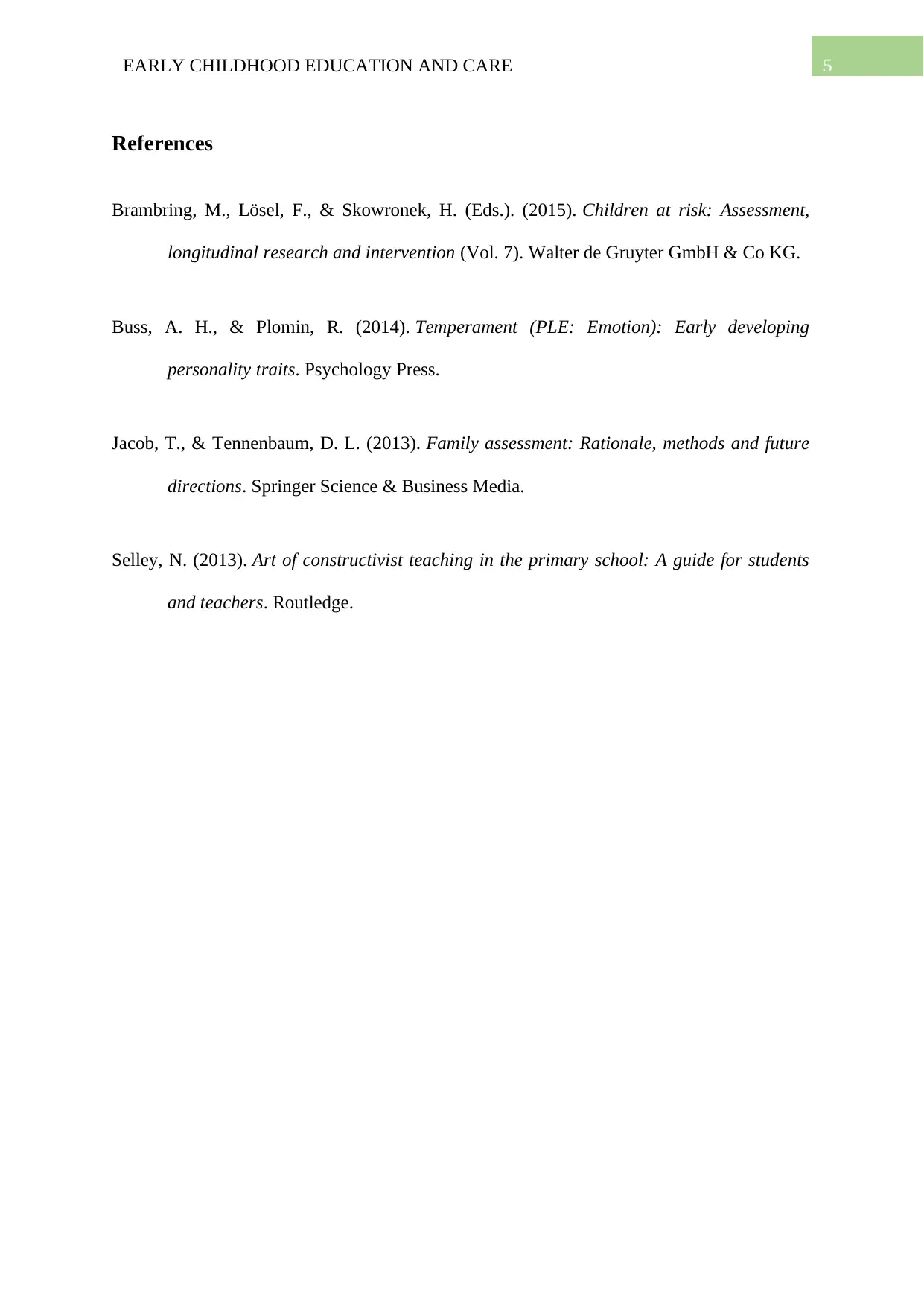
5EARLY CHILDHOOD EDUCATION AND CARE
References
Brambring, M., Lösel, F., & Skowronek, H. (Eds.). (2015). Children at risk: Assessment,
longitudinal research and intervention (Vol. 7). Walter de Gruyter GmbH & Co KG.
Buss, A. H., & Plomin, R. (2014). Temperament (PLE: Emotion): Early developing
personality traits. Psychology Press.
Jacob, T., & Tennenbaum, D. L. (2013). Family assessment: Rationale, methods and future
directions. Springer Science & Business Media.
Selley, N. (2013). Art of constructivist teaching in the primary school: A guide for students
and teachers. Routledge.
References
Brambring, M., Lösel, F., & Skowronek, H. (Eds.). (2015). Children at risk: Assessment,
longitudinal research and intervention (Vol. 7). Walter de Gruyter GmbH & Co KG.
Buss, A. H., & Plomin, R. (2014). Temperament (PLE: Emotion): Early developing
personality traits. Psychology Press.
Jacob, T., & Tennenbaum, D. L. (2013). Family assessment: Rationale, methods and future
directions. Springer Science & Business Media.
Selley, N. (2013). Art of constructivist teaching in the primary school: A guide for students
and teachers. Routledge.
⊘ This is a preview!⊘
Do you want full access?
Subscribe today to unlock all pages.

Trusted by 1+ million students worldwide
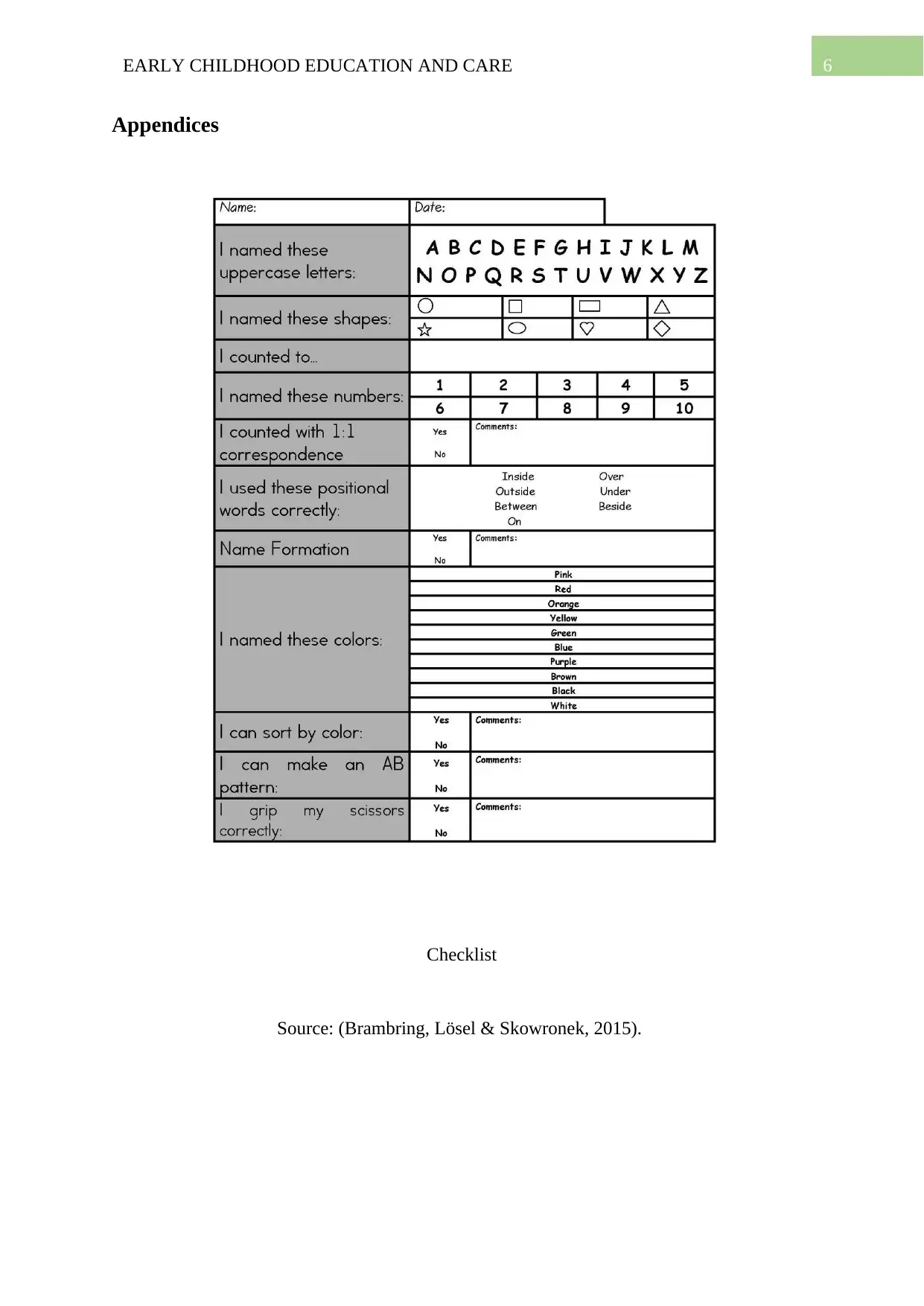
6EARLY CHILDHOOD EDUCATION AND CARE
Appendices
Checklist
Source: (Brambring, Lösel & Skowronek, 2015).
Appendices
Checklist
Source: (Brambring, Lösel & Skowronek, 2015).
Paraphrase This Document
Need a fresh take? Get an instant paraphrase of this document with our AI Paraphraser
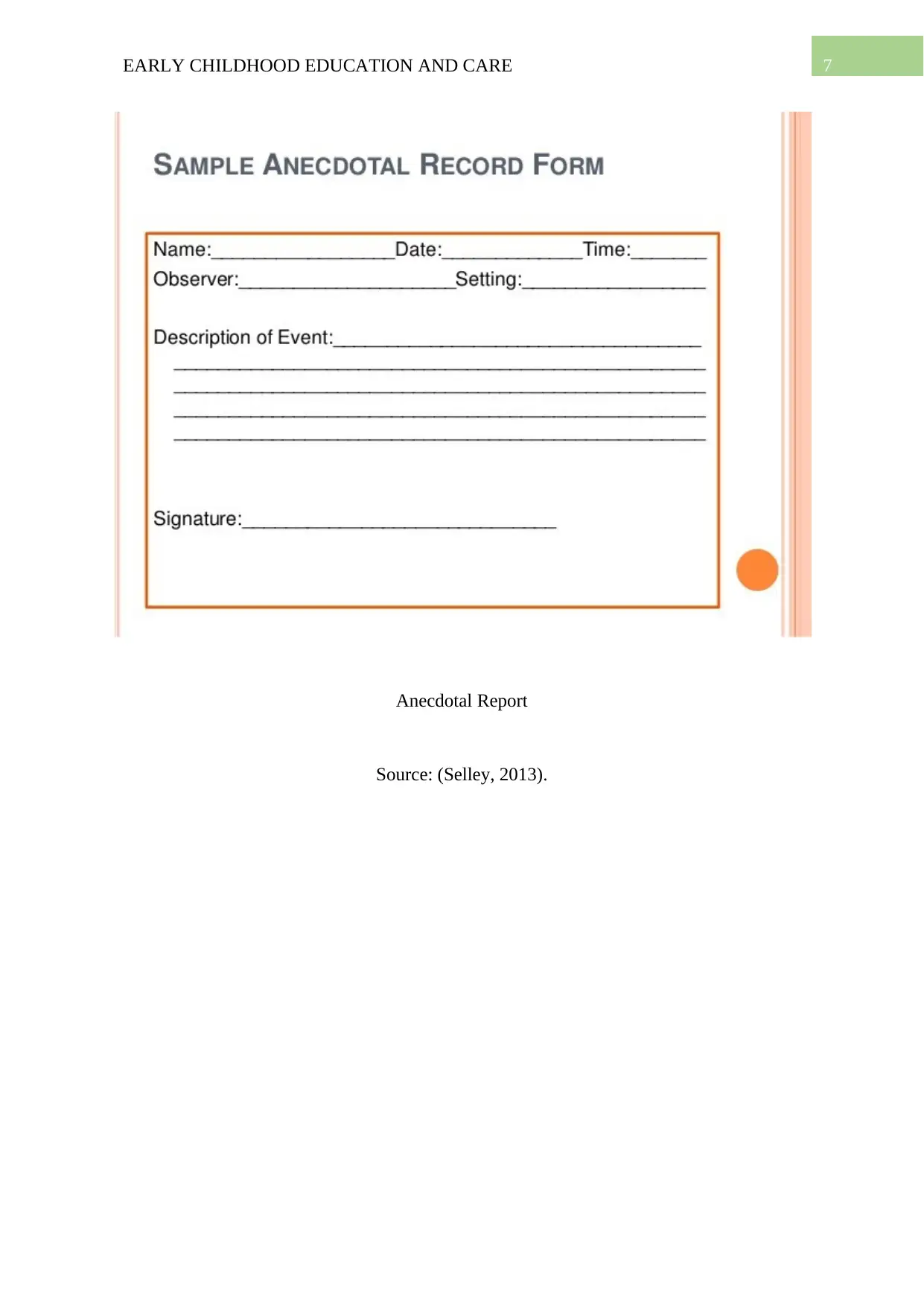
7EARLY CHILDHOOD EDUCATION AND CARE
Anecdotal Report
Source: (Selley, 2013).
Anecdotal Report
Source: (Selley, 2013).
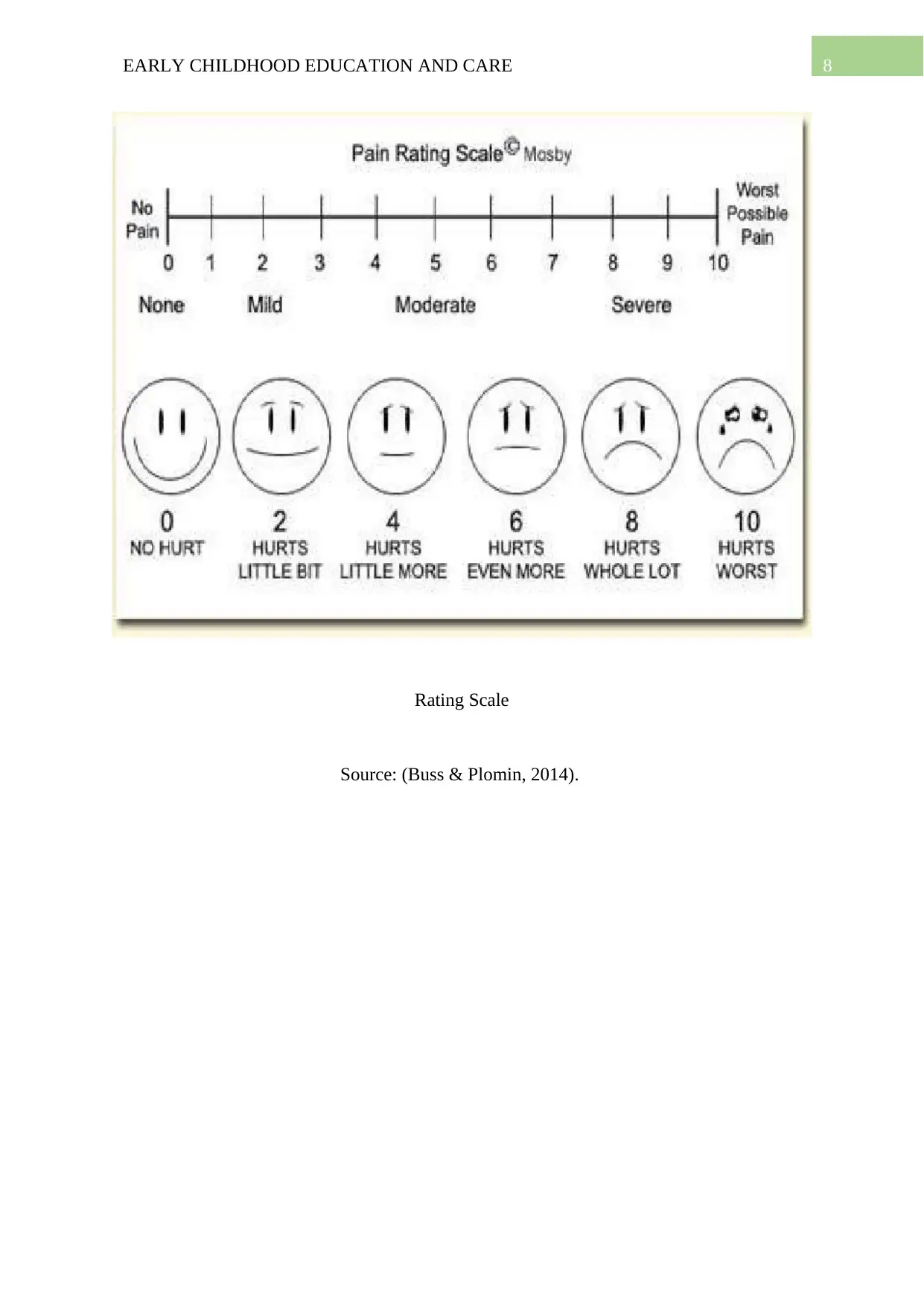
8EARLY CHILDHOOD EDUCATION AND CARE
Rating Scale
Source: (Buss & Plomin, 2014).
Rating Scale
Source: (Buss & Plomin, 2014).
⊘ This is a preview!⊘
Do you want full access?
Subscribe today to unlock all pages.

Trusted by 1+ million students worldwide
1 out of 9
Related Documents
Your All-in-One AI-Powered Toolkit for Academic Success.
+13062052269
info@desklib.com
Available 24*7 on WhatsApp / Email
![[object Object]](/_next/static/media/star-bottom.7253800d.svg)
Unlock your academic potential
Copyright © 2020–2025 A2Z Services. All Rights Reserved. Developed and managed by ZUCOL.





